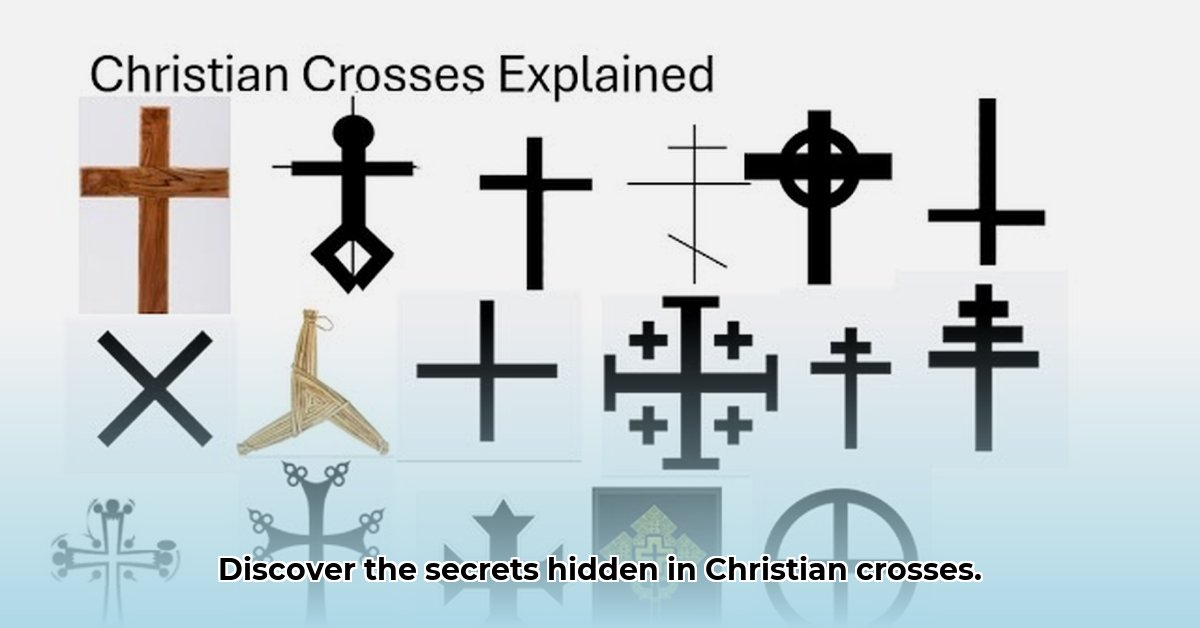
The Christian cross, a potent symbol of faith, transcends a simple geometric shape. Its diverse forms—each imbued with unique historical, cultural, and theological significance—tell a captivating story of Christianity's evolution. From the ubiquitous Latin cross to the less familiar Celtic and Russian Orthodox crosses, this guide unravels the intricacies of these powerful emblems. Understanding these variations enhances our appreciation for the diverse expressions of faith across cultures and centuries. For a deeper dive into cross types, check out this helpful resource.
The Latin Cross: The Foundation of Christian Symbolism
The Latin cross, characterized by its longer vertical beam and shorter horizontal one, reigns as the most recognizable Christian symbol globally. The vertical beam often represents Christ's unwavering faith and righteousness, while the horizontal beam symbolizes the world and the sacrifice He made for humanity. Its simplicity contributes to its enduring power and widespread recognition. Have you ever considered the subtle yet profound message conveyed by this seemingly simple design?
(Placeholder image - replace with high-quality image)
History: Adopted as the primary Christian symbol in the early centuries CE, its prominence solidified over time, becoming ubiquitous across denominations and cultures.
Symbolism: Uprightness, sacrifice, the intersection of heaven and earth.
Variations: Few variations exist, primarily concerning the proportions of the arms.
The Greek Cross: Symmetry and Divine Harmony
Unlike the Latin cross, the Greek cross features arms of equal length, creating a perfect square. This symmetry often conveys balance, harmony, and the completeness of Christ's work. Frequently featured in Eastern Orthodox churches, it visually emphasizes spiritual equilibrium and the all-encompassing nature of God's love. The visual balance is striking; how does this difference in design reflect contrasting theological perspectives?
(Placeholder image - replace with high-quality image)
History: Early adoption, particularly prevalent in Eastern Christianity.
Symbolism: Balance, harmony, completeness, the four corners of the earth.
Variations: Minimal variations exist, largely in its decorative elements.
The Celtic Cross: A Fusion of Faith and Artistic Heritage
The Celtic cross uniquely blends Christian symbolism with the rich artistic traditions of Celtic culture. Its characteristic feature—a ring encircling the intersection of the cross's arms—symbolizes eternity, unity, and the continuous, never-ending nature of God's love. Intricate knotwork frequently adorns these crosses, reflecting the deep-rooted artistry of Celtic craftsmanship. What other religious symbol so seamlessly incorporates ancient cultural motifs?
(Placeholder image - replace with high-quality image)
History: Emerged in early medieval Ireland and spread throughout Celtic regions.
Symbolism: Eternity, continuity, unity, the fusion of pagan and Christian beliefs.
Variations: Numerous variations exist, reflecting regional stylistic differences.
The Patriarchal Cross: Layers of Theological Significance
The Patriarchal cross, a prominent symbol in the Eastern Orthodox Church, adds three smaller horizontal bars to the basic Latin cross. Each bar holds specific theological significance, representing various aspects of Christ's life, ministry, and triumph over death. This complex design often implies higher authority and a deeper engagement with the complexities of faith. How does the addition of these bars strengthen the visual representation of faith?
(Placeholder image - replace with high-quality image)
History: Widely used within the Eastern Orthodox tradition.
Symbolism: Multiple aspects of Christ's life and the Trinity; hierarchical authority.
Variations: Minor variations exist in the placement and size of the additional bars.
The Maltese Cross: A Symbol of Knighthood and Devotion
Strongly associated with the Knights Hospitaller, a medieval military order, the eight-pointed Maltese cross communicates protection, strength, and unwavering faith. This distinct shape is more than a design; it's a powerful reminder of the courage and devotion of these knights who dedicated their lives to serving others. Did you know its sharp angles might symbolize the piercing power of faith?
(Placeholder image - replace with high-quality image)
History: Associated with the Knights Hospitaller and other chivalric orders.
Symbolism: Protection, strength, unwavering faith, service, sacrifice.
Variations: Minimal variations, primarily in the intricacy of its design.
A Quick Reference Guide: Christian Crosses at a Glance
| Cross Type | Description | Significance |
|---|---|---|
| Latin Cross | Vertical and horizontal beams; unequal length | Most common and foundational Christian symbol. |
| Greek Cross | Arms of equal length | Symmetry, balance, wholeness of Christ's work. |
| Celtic Cross | Latin cross with a circle | Eternity, unity, enduring nature of faith. |
| Patriarchal Cross | Latin cross with three shorter horizontal beams | Hierarchical authority; multiple aspects of Christ's life. |
| Maltese Cross | Eight-pointed cross | Protection, strength, faith; associated with the Knights. |
This overview offers a glimpse into the rich tapestry of Christian cross symbolism. Further exploration will reveal even deeper insights into their diverse meanings and enduring relevance. Understanding these symbols enhances our appreciation for the varied expressions of faith across history and cultures.